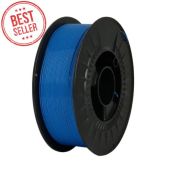We use cookies to make your experience better. Read more
18 Aprile, 2025
How to Print PETG: Mastering a Durable 3D Filament
Understanding PETG and Why It Matters
PETG (Polyethylene Terephthalate Glycol) is a glycol-modified version of the common PET material, best known for its role in plastic bottles. This modification makes PETG clearer, more temperature-resistant, and easier to extrude in 3D printing. A blend of PLA’s ease of use and ABS’s toughness, PETG is a favorite among those who require durability, chemical resistance, and visual appeal in their 3D prints.
It’s often used in both artistic and functional applications, such as protective casings, mechanical parts, display items, and containers. Thanks to its impact strength and chemical resistance, PETG is also well-suited for outdoor use and even food-safe applications (depending on the manufacturer).
Print Settings: The Essentials for PETG
Getting great results with PETG depends on dialing in the right print settings. Here's what to focus on:
- Temperature Range
Extruder temperature: 220-260°C
Bed temperature: 70-80°C
Maintaining these ranges ensures excellent layer adhesion and a smooth finish. Going too high may lead to stringing and blobs; too low can result in weak prints and poor bonding. - Print Speed
PETG generally prints best at moderate speeds. Starting at 40-60 mm/s gives you more control, especially while fine-tuning. - Retraction Settings
PETG tends to string more than PLA. Optimize retraction distance and speed to limit oozing. Use retraction test prints to dial these in. - Cooling
Low fan speeds (around 25%) are recommended. Cooling helps with overhangs but too much can weaken layer bonding. Avoid cooling the first few layers to improve bed adhesion.
Common Issues and How to Fix Them
- Stringing: Lower the nozzle temperature slightly and optimize retraction.
- Warping: Use PEI or a textured build surface and maintain correct bed temperatures.
- Poor Bed Adhesion: Ensure the bed is level and clean. Use a glue stick or hair spray if needed.
- Nozzle Clogging: Let the hot end cool properly, dry filament before printing, and check for blockages regularly.
- Moisture Absorption: Store filament in a dry box and dry before use.
PETG vs Other Filaments
PETG offers a unique balance of strength, durability, and ease of use. Compared to PLA, it’s stronger, more flexible, and has better temperature resistance. Unlike ABS, it emits no toxic fumes and doesn’t require an enclosed print chamber.
Best Use Cases for PETG
- Mechanical parts that endure stress or movement
- Outdoor items that require UV and moisture resistance
- Transparent containers and product displays
- Food containers (manufacturer-dependent)
- Functional models like brackets or enclosures
With the right settings, PETG delivers both aesthetically pleasing and highly functional prints.
Post-Processing PETG Prints
PETG doesn’t dissolve in acetone like ABS, so smoothing requires manual effort. Sanding followed by a clear coat gives prints a polished finish. PETG doesn’t take paint as easily, so priming is recommended for painted models.
Tips for Getting the Best Results
- Dry your filament: PETG absorbs moisture easily. Dry it at around 60°C for a few hours before use.
- Use the right build surface: PEI or glass with adhesive yields the best results.
- Don’t overcool: Too much fan can lead to poor adhesion and warping.
- Store properly: Keep unused PETG in an airtight container with desiccant.
- Experiment slowly: When changing settings, adjust only one variable at a time to understand its impact.
Why Choose 3D Trček for Your 3D Material Needs?
3D Trček is a family-run business focused on producing high-quality thermoplastic and silicone rubber products. Our expertise spans a variety of materials including PVC, PP, PE, PS, PA, EVA, PMMA, PU, ABS, TPE, and silicone rubber. We offer everything from toolmaking to final product delivery, and we always provide honest advice on material selection.
At 3D Trček, we pride ourselves on fast turnaround times, excellent customer service, and a personal touch. If you're working with PETG or any other advanced filament, we can help you find the best solution for your project. Visit us at 3dtrcek.com to learn more.
Comment(s)



Please complete your information below to login.
Accedi
Creare un nuovo account